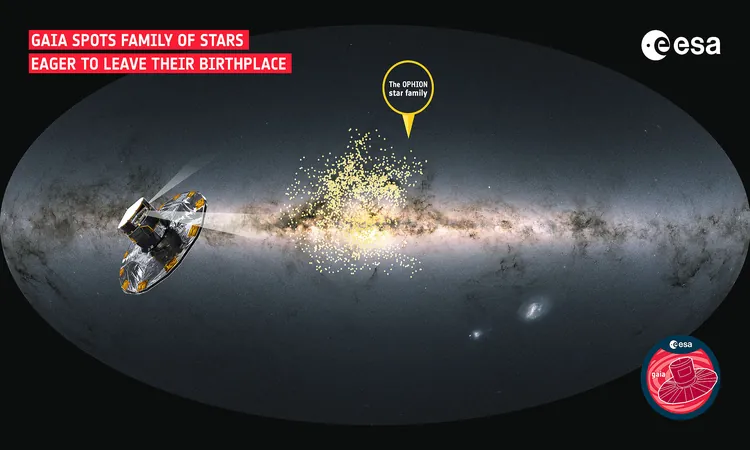
Galactic Surprise: The Star Cluster Ophion Defies All Expectations!
2025-05-07
Author: Arjun
A Celestial Anomaly at 650 Light-Years Away
In a revolutionary discovery from the European Space Agency's Gaia mission, a star cluster named Ophion has been unveiled, and it’s unlike anything we've seen before. Located about 650 light-years from Earth, this cluster is challenging the norm by breaking apart at an astonishing speed that defies the typical lifespan of star families.
Meet Ophion: The Chaotic Star Family
Traditionally, stars born in clusters tend to either drift away slowly or stick together for extended periods. However, Ophion is exhibiting a wild, unpredictable motion that leaves researchers baffled. "Ophion is filled with stars rushing across the galaxy in a disorganized frenzy," says scientist Dylan Huson from Western Washington University. This cluster, filled with young stars less than 20 million years old, may scatter more rapidly than expected for a group of its size.
What Sparked the Chaos?
So what could be causing this stellar upheaval? Some astronomers speculate that nearby supernova explosions may have blasted away the surrounding gas, pushing Ophion’s stars to split at breakneck speed. The influential environment surrounding Ophion, near massive stellar groups, adds another layer of mystery, hinting at possible connections that remain unexplored.
Others propose that internal dynamics might be at play, causing a chain reaction that ignited this chaotic dispersion. "The exact cause of this star family's erratic behavior is still a mystery," notes co-author Marina Kounkel.
Unlocking the Secrets of Our Galaxy
Researching dynamic clusters like Ophion provides valuable insights into the evolution of the Milky Way. As scientists observe these massive families breaking apart, they uncover how clustering affects solitary stars and the galaxy’s structure. Unlike older star groupings that follow predictable paths, Ophion serves as a reminder of the galactic mysteries yet to be solved.
The Future of Ophion's Exploration
While Gaia's data collection ceased in March after an impressive decade mapping the cosmos, exciting revelations are still on the horizon. The forthcoming comprehensive Gaia catalogs promise deeper insights and may reveal whether other young clusters exhibit similar erratic behaviors as Ophion.
Although this chaotic star family poses no threat to Earth, it opens the door for testing leading theories of star formation and group evolution. Observing such startling movements could redefine our understanding of how entire stellar neighborhoods unravel under extreme conditions.
A New Chapter in Astronomical Studies
The study of Ophion not only highlights the diverse processes within our galaxy but also encapsulates the thrill of cosmic discovery. Catching a young cluster in the act of chaotic dispersal enhances our models of star formation and sheds light on the origins of stars, including our very own sun. This groundbreaking research has been published in The Astrophysical Journal, laying the groundwork for future explorations.
Stay tuned as we continue to unveil the wonders of the universe!


 Brasil (PT)
Brasil (PT)
 Canada (EN)
Canada (EN)
 Chile (ES)
Chile (ES)
 Česko (CS)
Česko (CS)
 대한민국 (KO)
대한민국 (KO)
 España (ES)
España (ES)
 France (FR)
France (FR)
 Hong Kong (EN)
Hong Kong (EN)
 Italia (IT)
Italia (IT)
 日本 (JA)
日本 (JA)
 Magyarország (HU)
Magyarország (HU)
 Norge (NO)
Norge (NO)
 Polska (PL)
Polska (PL)
 Schweiz (DE)
Schweiz (DE)
 Singapore (EN)
Singapore (EN)
 Sverige (SV)
Sverige (SV)
 Suomi (FI)
Suomi (FI)
 Türkiye (TR)
Türkiye (TR)
 الإمارات العربية المتحدة (AR)
الإمارات العربية المتحدة (AR)